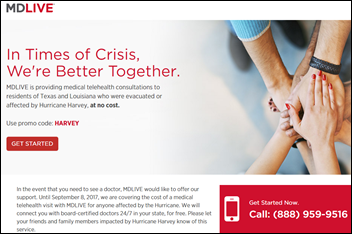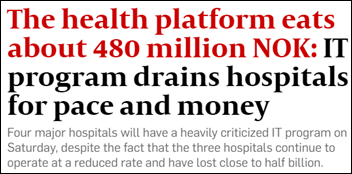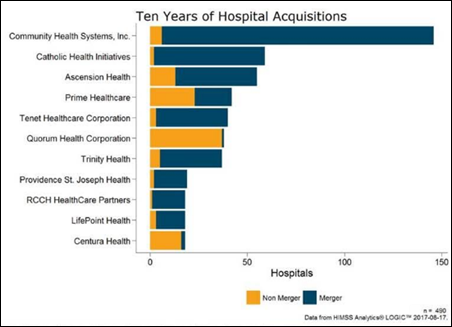News 9/22/17
Top News

Politico reports that HHS Secretary Tom Price, MD took five flights on private jets between September 13 and 15 “at a cost of tens of thousands of dollars more than commercial travel.” Price’s destinations included Athenahealth’s MDP event in Maine, the Goodwin Community Health Center in New Hampshire, and the Mirmont Treatment Center in Pennsylvania. Those organizations have confirmed that they did not cover Price’s travel costs. HHS spokeswoman Charmaine Yoest has said that those flights “were important for him to get outside of Washington, DC, talk to real people on the ground, and using the travel arrangements we did was the best way to get him there.”
Other Trump administration officials have come under fire for their lack of fiscally responsible flying. Officials are reviewing travel expenses for Treasury Secretary Steve Mnuchin, who used an Air Force jet to visit Kentucky in August and later requested a military flight for his honeymoon (allegedly for security reasons); and for EPA Administrator Scott Pruitt, who has spent a considerable amount of money on commercial flights to his home in Oklahoma.
Reader Comments

From Dave: “Re: Equifax post-breach customer service. From what I understand, if you go to the Equifax site and sign up for the free credit monitoring that they’re offering, the current terms and conditions that are agreed to by clicking through it, according to an attorney I was told about, say that you are hereby waiving any rights to participate in a class action suit. When the attorney called and asked Equifax about that, they told him not to worry and that it won’t apply in this case. Yet, they haven’t changed it and people are clicking on it. And it’s only there because of this very breach. Sounds fishy to me.”
HIStalk Announcements and Requests
This week on HIStalk Practice: KeyCare will implement I2I Population Health’s PHM technology across 16 community health centers. HRSA earmarks $200 million to help health centers expand mental health and substance abuse services. Bend Medical Clinic hopes to climb out of EHR-related financial troubles with help from Summit Health. Providers react to Jonathan Bush’s burning question. VillageMD launches in Georgia. CMS Innovation Center pursues new direction. Physician burnout becomes a vicious cycle. PRM Pro Jim Higgins emphasizes communication preferences in improving patient retention.

Last call: HIStalk sponsors, submit your MGMA details for inclusion in our annual must-see vendor’s guide over at HIStalk Practice. Companies that are walking the show floor instead of exhibiting are also welcome to submit their information. The guide will publish the week of October 2.
Webinars
September 28 (Thursday) 2:00 ET. “Leverage the Psychology of Waiting to Boost Patient Satisfaction.” Sponsored by: DocuTap. Presenter: Mike Burke, founder and CEO, Clockwise.MD. Did you know that the experience of waiting is determined less by the overall length of the wait and more by the patient’s perception of the wait? In the world of on-demand healthcare where waiting is generally expected, giving patients more ways to control their wait time can be an effective way to attract new customers—and keep them. In this webinar, attendees will learn how to increase patient satisfaction by giving patients control over their own waiting process. (Hint: it’s not as scary as it sounds!)
October 19 (Thursday) 12:00 ET. “Understanding Enterprise Health Clouds with Forrester: What can they do for you, and how do you choose the right one?” Sponsored by: Salesforce. Presenters: Joshua Newman, MD CMO, Salesforce; and Kate McCarthy, senior analyst, Forrester. McCarthy will demystify industry solutions while offering insights from her recent Forrester report on enterprise health clouds. Newman and customers from leading healthcare organizations will share insights on how they drive efficiencies, manage patient and member journeys, and connect the entire healthcare ecosystem on the Salesforce platform.
November 8 (Wednesday) 1:00 ET. “How Clinically Integrated Networks Can Overcome the Technical Challenges to Data-Sharing.” Sponsored by: Liaison Technologies. Presenters: Dominick Mack, MD executive medical director, Georgia Health Information Technology Extension Center and Georgia Health Connect; director, National Center for Primary Care; and associate professor, Morehouse School of Medicine; and Gary Palgon, VP, healthcare and life sciences solutions, Liaison Technologies. This webinar will describe how Georgia Heath Connect connects clinically integrated networks to hospitals and small and rural practices, helping providers in medically underserved communities meet MACRA requirements by providing technology, technology support, and education that accelerates regulatory compliance and improves outcomes.
Previous webinars are on our YouTube channel. Contact Lorre for information on webinar services.
Acquisitions, Funding, Business, and Stock

Video interpretation and telemedicine company Stratus Video opens a Center of Excellence in Dallas. The company expects to hire 200 employees from the area within the year.
Moffitt Cancer Center’s (FL) informatics subsidiary, M2Gen, will use an undisclosed amount of equity investment from Hearst to expand its cancer research efforts and data-sharing network.
The Dallas News cites unnamed analysts in an article claiming that HCA is a frontrunner to acquire some of Tenet Healthcare’s hospitals.
Sales

Christus Health system (TX) selects Influence Health’s CRM software.
People

Biomedical informaticist Neil Sarkar (Brown University) takes the editorial helm of AMIA’s new JAMIA Open publication.

PeraHealth names LeAnne Hester (Premier) chief commercial officer.

Great Lakes Health Connect Executive Director Doug Dietzman will also lead Making Choices Michigan, a nonprofit focused on advance care planning that became a wholly owned subsidiary of GLHC earlier this month.
Announcements and Implementations

University of Kansas Health System rolls out speech-recognition software and EHR services from Nuance.

Baptist Health Corbin (KY) implements tele-ICU services from Advanced ICU Care.
Technology
![]()
Intelligent Contacts develops a service that helps hospital collections staff bypass lengthy hold times when trying to get in touch with payers.

Providers can now access Doximity Dialer from within Epic’s Haiku mobile app. Dialer gives users the ability to call patients from their smart phones with one touch, while guarding the privacy of their personal phone numbers.

Amazon looks to give recently revitalized Google Glass a run for its money with Alexa-enabled smart glasses, the company’s first wearable. Users will be able to hear Alexa courtesy of a wireless bone-conduction audio system, and could wirelessly tether to a smartphone. Google Glass founder Babak Parviz joined Amazon in 2014.
LiveData launches a cloud-based version of its PeriOp Manager technology.
National Decision Support Co. works with Mayo Clinic (MN) to develop a real-time decision-support tool for laboratory testing available within the EHR via the company’s CareSelect software.
ClinicTracker end users gain lab connectivity via EHR integration with Change Healthcare’s Clinical Network.
Privacy and Security

In its latest monthly update, Protenus reports that healthcare organizations experienced 31 breaches affecting 673,934 patient records – stats in keeping with the preceding seven months. Hackers were responsible for 55 percent of breaches, while insiders racked up 27 percent, pointing to a continued need for cybersecurity training.
Government and Politics


VA Interim Deputy Secretary Scott Blackburn will assume the role of acting CIO when Rob Thomas retires next month. Thomas took on the role in February after CIO LaVerne Council departed with the Obama administration.

The CMS Innovation Center asks for stakeholder feedback as it considers a “new direction to promote patient-centered care and test market-driven reforms that empower beneficiaries as consumers, provide price transparency, increase choices and competition to drive quality, reduce costs, and improve outcomes.” CMS Administrator Seema Verma says in a Wall Street Journal op-ed that the agency will pivot its Innovation Center to offer providers new ways of delivering care, noting that value-based programs have resulted in market consolidation and reduced competition. Comments are due November 20.

Niam Yaraghi, a fellow in the Brookings Institution’s Center for Technology Innovation, argues in a Health Affairs blog that HITECH and HIPAA are as much at fault for the nation’s EHR interoperability problems as the vendors and providers that are being blamed. He recommends enacting policies that would give providers and vendors the option of charging fees for the the exchange of medical data, a move that would “unleash the long-awaited incentives for information exchange in the healthcare industry and open the floodgates of medical data to allow patients to access, manage, and transmit their medical data as easily as their financial data.”
Other

“Where are helicopter parents when you need them?” asks Weird News Andy after learning that doctors in Wales put a two year-old’s cast on the wrong leg. After taking the child back to the clinic a day later, the child’s mother says clinic workers were “making out as if it was my fault for not checking which leg it had been put on at the time. I told them that it wasn’t my duty to be aware of that and point out their mistake.”

WNA shakes his head at the fact that Equifax linked to a fake customer support site that mocked the company’s breach follow-up for several days before realizing its mistake. The company’s Twitter account even got in on the action. Ars Technica reports that a security researcher developed the fake site to emphasize how easy it is to fool people into clicking on links and giving up personal details.
Sponsor Updates
- EClinicalWorks will exhibit at the SFMGMA Annual Healthcare Symposium September 22 in Fort Lauderdale, FL.
- Evariant makes the Marcum Tech Top 40 list of fastest growing technology companies in Connecticut.
- Healthfinch, Imprivata, and Intelligent Medical Objects will exhibit at Epic UGM 2017 September 26-27 in Verona, WI.
- Healthgrades will sponsor and present at Denver Startup Week September 26-27.
- Consulting Magazine includes Impact Advisors on its list of best small firms to work for.
- Kyruus will exhibit at SHSMD Connections September 24-27 in Orlando.
- Inc. profiles NTT Data’s wearable technology relationship with IndyCar driver Tony Kanaan.
- Black Book’s 2017 report ranks ZirMed first for end-to-end RCM for the seventh consecutive year.
- Frost & Sullivan recognizes Sunquest Information Systems for its strides in precision medicine and patient-centered healthcare.
- Forward Health Group will host the Greater Madison Chamber of Commerce – HealthTech Capitol Views & Brews event September 24 in Madison, WI.
Blog Posts
- Top Revenue Cycle Management Issues that Impact Compliance: Patient-Focused Compliance Issues (ECG Management Consultants)
- Grove Medical: Tackling Diabetes with Healthcare IT (EClinicalWorks)
- 3 Tips for Improving Millenial Patient Engagement (Evariant)
- Restoring the Joy in Clinical Practice (Hayes Management Consulting)
- HGP Closes its 100th Transaction! (Healthcare Growth Partners)
- Ignorance, Bliss, and the Zen of Risk Management (Iatric Systems)
- Streamlined Training Reporting During an EHR Implementation (Impact Advisors)
- Five Questions You Should Be Asking About Cybersecurity (Imprivata)
- Making Google Analytics Work for Your Healthcare Organization (Influence Health)
- There are No Cliffs Notes for PoS Payment Device Security in Healthcare (InstaMed)
- Managing Your Brand’s Reputation Across the Web (Kyruus)
- Aim For more: Beyond the Triple Aim in Healthcare (Infor)
- The Importance of Proper Scheduling before an EHR Go-Live (Leidos Health)
- Why 3 separate hospitals started an HIE together (Meditech)
- 8 Ways to Reduce Alarm Fatigue in Hospitals (Spok)
- The four types of struggling project managers (and how to improve) (Nordic)
Contacts
Mr. H, Lorre, Jenn, Dr. Jayne, Lt. Dan.
Get HIStalk updates. Send news or rumors.
Contact us.


































































































































































































































































































Merry Christmas and a Happy New Year to the HIStalk crowd. I wish you the joys of the season!